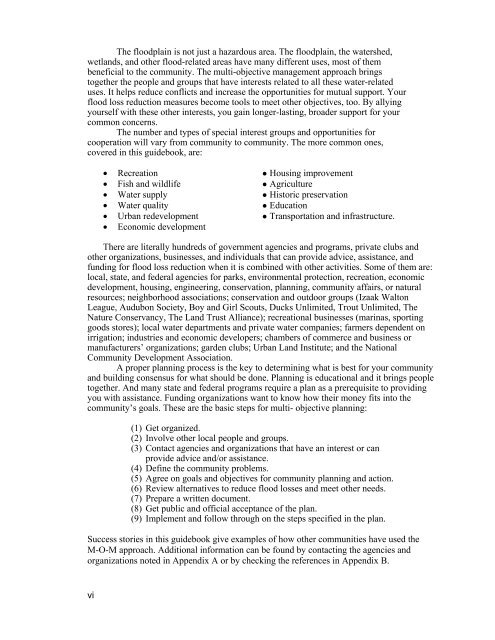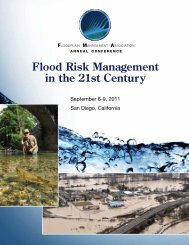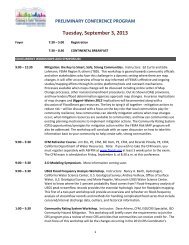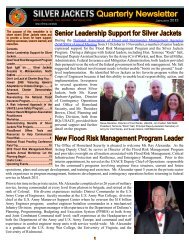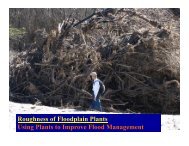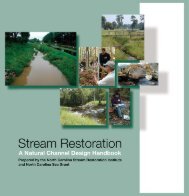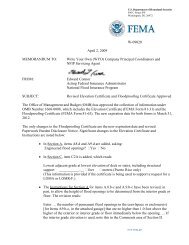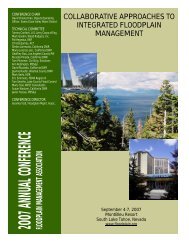Using Multi-Objective Management to Reduce Flood Losses in Your
Using Multi-Objective Management to Reduce Flood Losses in Your
Using Multi-Objective Management to Reduce Flood Losses in Your
You also want an ePaper? Increase the reach of your titles
YUMPU automatically turns print PDFs into web optimized ePapers that Google loves.
The floodpla<strong>in</strong> is not just a hazardous area. The floodpla<strong>in</strong>, the watershed,<br />
wetlands, and other flood-related areas have many different uses, most of them<br />
beneficial <strong>to</strong> the community. The multi-objective management approach br<strong>in</strong>gs<br />
<strong>to</strong>gether the people and groups that have <strong>in</strong>terests related <strong>to</strong> all these water-related<br />
uses. It helps reduce conflicts and <strong>in</strong>crease the opportunities for mutual support. <strong>Your</strong><br />
flood loss reduction measures become <strong>to</strong>ols <strong>to</strong> meet other objectives, <strong>to</strong>o. By ally<strong>in</strong>g<br />
yourself with these other <strong>in</strong>terests, you ga<strong>in</strong> longer-last<strong>in</strong>g, broader support for your<br />
common concerns.<br />
The number and types of special <strong>in</strong>terest groups and opportunities for<br />
cooperation will vary from community <strong>to</strong> community. The more common ones,<br />
covered <strong>in</strong> this guidebook, are:<br />
• Recreation ● Hous<strong>in</strong>g improvement<br />
• Fish and wildlife ● Agriculture<br />
• Water supply ● His<strong>to</strong>ric preservation<br />
• Water quality ● Education<br />
• Urban redevelopment ● Transportation and <strong>in</strong>frastructure.<br />
• Economic development<br />
There are literally hundreds of government agencies and programs, private clubs and<br />
other organizations, bus<strong>in</strong>esses, and <strong>in</strong>dividuals that can provide advice, assistance, and<br />
fund<strong>in</strong>g for flood loss reduction when it is comb<strong>in</strong>ed with other activities. Some of them are:<br />
local, state, and federal agencies for parks, environmental protection, recreation, economic<br />
development, hous<strong>in</strong>g, eng<strong>in</strong>eer<strong>in</strong>g, conservation, plann<strong>in</strong>g, community affairs, or natural<br />
resources; neighborhood associations; conservation and outdoor groups (Izaak Wal<strong>to</strong>n<br />
League, Audubon Society, Boy and Girl Scouts, Ducks Unlimited, Trout Unlimited, The<br />
Nature Conservancy, The Land Trust Alliance); recreational bus<strong>in</strong>esses (mar<strong>in</strong>as, sport<strong>in</strong>g<br />
goods s<strong>to</strong>res); local water departments and private water companies; farmers dependent on<br />
irrigation; <strong>in</strong>dustries and economic developers; chambers of commerce and bus<strong>in</strong>ess or<br />
manufacturers’ organizations; garden clubs; Urban Land Institute; and the National<br />
Community Development Association.<br />
A proper plann<strong>in</strong>g process is the key <strong>to</strong> determ<strong>in</strong><strong>in</strong>g what is best for your community<br />
and build<strong>in</strong>g consensus for what should be done. Plann<strong>in</strong>g is educational and it br<strong>in</strong>gs people<br />
<strong>to</strong>gether. And many state and federal programs require a plan as a prerequisite <strong>to</strong> provid<strong>in</strong>g<br />
you with assistance. Fund<strong>in</strong>g organizations want <strong>to</strong> know how their money fits <strong>in</strong><strong>to</strong> the<br />
community’s goals. These are the basic steps for multi- objective plann<strong>in</strong>g:<br />
(1) Get organized.<br />
(2) Involve other local people and groups.<br />
(3) Contact agencies and organizations that have an <strong>in</strong>terest or can<br />
provide advice and/or assistance.<br />
(4) Def<strong>in</strong>e the community problems.<br />
(5) Agree on goals and objectives for community plann<strong>in</strong>g and action.<br />
(6) Review alternatives <strong>to</strong> reduce flood losses and meet other needs.<br />
(7) Prepare a written document.<br />
(8) Get public and official acceptance of the plan.<br />
(9) Implement and follow through on the steps specified <strong>in</strong> the plan.<br />
Success s<strong>to</strong>ries <strong>in</strong> this guidebook give examples of how other communities have used the<br />
M-O-M approach. Additional <strong>in</strong>formation can be found by contact<strong>in</strong>g the agencies and<br />
organizations noted <strong>in</strong> Appendix A or by check<strong>in</strong>g the references <strong>in</strong> Appendix B.<br />
vi


